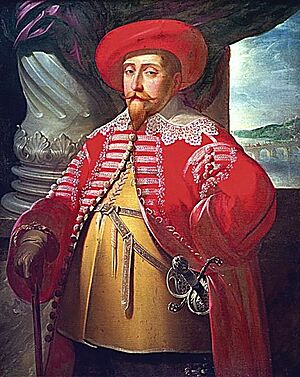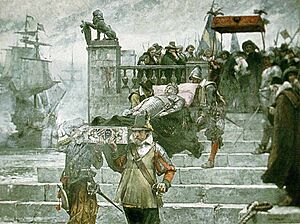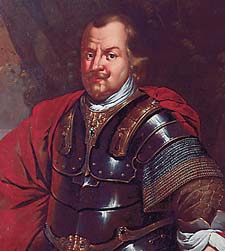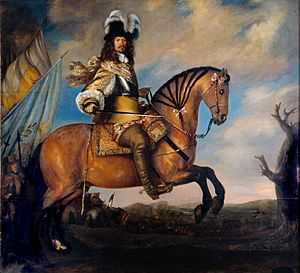Treaty of Stettin (1630) facts for kids
The Treaty of Stettin was an important agreement that allowed the Swedish Empire to take control of the Duchy of Pomerania during the Thirty Years' War. This treaty was signed on September 4, 1630 (or August 25, 1630, by an older calendar). However, it was made to look like it was signed earlier, on July 20, 1630 (or July 10, 1630), which was when Swedish soldiers first landed in Pomerania.
With this treaty, Sweden gained military power in Pomerania. They used this area as a starting point to launch attacks into Central and Southern Germany. After the last duke of Pomerania died in 1637, forces from the Holy Roman Empire tried to take over Pomerania. They wanted to support Brandenburg's claim to the land. But Sweden defeated them in battles. Some of the local nobles in Pomerania even switched sides to support Brandenburg.
By the end of the war, the Treaty of Stettin was replaced by the Peace of Westphalia in 1648. Later, the Treaty of Stettin (1653) officially divided Pomerania. The western part became Swedish Pomerania, controlled by Sweden. The eastern part, called Farther Pomerania, went to Brandenburg and became the Brandenburg-Prussian Province of Pomerania.
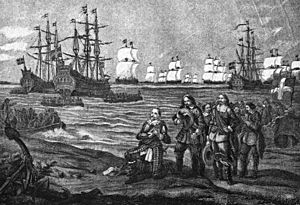
Contents
Why the Treaty Was Needed
After the Capitulation of Franzburg in 1627, the Duchy of Pomerania was taken over by soldiers of Ferdinand II, Holy Roman Emperor. These soldiers were led by Albrecht von Wallenstein.
Sweden got involved in the Thirty Years' War by helping Stralsund. Stralsund was a port city in Pomerania that belonged to the Hanseatic League. It had successfully fought off the emperor's soldiers with help from Denmark and Sweden. Sweden and Stralsund then made an alliance that would last for twenty years.
Denmark's battles in Pomerania and other parts of the Holy Roman Empire ended with the Battle of Wolgast in 1628 and the Treaty of Lübeck in 1629. After this, almost all of Northern Germany, except Stralsund, was controlled by the emperor's forces and the Catholic League. In 1629, the emperor tried to make these Protestant areas Catholic again. He did this by issuing the Edict of Restitution.
The Truce of Altmark ended the Polish–Swedish War (1626–1629) in September 1629. This freed up Swedish soldiers to invade the Holy Roman Empire. Gustavus Adolphus of Sweden had already planned this invasion.
On July 6, 1630 (or June 26, 1630, by an older calendar), Gustavus Adolphus arrived with 27 ships and 13,000 soldiers near Peenemünde on the island of Usedom. The main part of his army was made up of trained farmers. These farmers had joined the Swedish army because of Gustavus Adolphus's military changes in 1623.
Sweden said they were invading for several reasons:
- They were left out of the Treaty of Lübeck (1629).
- The emperor had helped Poland in the Polish–Swedish War (1626–1629).
- They wanted to free German Protestants.
- They wanted to bring back German freedom.
The Swedish landing force faced the emperor's soldiers in Pomerania. These soldiers were led by Torquato Conti. Many of the emperor's soldiers were busy fighting in Italy, so they couldn't react quickly. Wallenstein, who had defeated Danish forces in the same place two years earlier, was about to be fired. On July 9, Swedish forces took Stettin (now Szczecin). For the rest of 1630, they focused on securing their position around the Oder river.
The Treaty and Its Changes
The first plan for an alliance between Sweden and Pomerania was rejected by Gustavus Adolphus of Sweden. Pomeranian leaders had been working on it since July 20, 1630. A second plan was sent back with a list of changes that Sweden wanted. Real talks between Sweden and Pomerania began on August 22, 1630. Gustavus Adolphus himself joined these talks on September 1, 1630. The final negotiations lasted from September 2 to 4, 1630.
The actual agreement was made on September 4, 1630 (or August 25, 1630, by an older calendar). But it was dated earlier, to July 20, 1630 (or July 10, 1630). The alliance was meant to last "forever." The treaty also included the alliance Sweden had made with Stralsund in 1628. That alliance happened when Stralsund resisted the Capitulation of Franzburg and was under attack by Albrecht von Wallenstein's army.
Later agreements included the "Pomeranian Defense Constitution" of August 30, 1630, and the "Quartering Order" of 1631. These agreements gave the Swedish king and his top officers complete control over Pomerania's military. However, the dukes, nobles, and towns kept their political and religious power. Sweden was in charge of Pomerania's foreign affairs. These extra agreements were needed because the Pomeranian nobles wanted the military control to be separate from the main alliance.
Pomerania had to pay 100,000 Talers each year to Sweden. They also had to provide supplies for four Swedish military bases.
How the Alliance Worked
Sweden's Control in Pomerania
When Bogislaw XIV, Duke of Pomerania agreed to the alliance, he immediately wrote a letter to Ferdinand II, Holy Roman Emperor. He said the alliance was not against the emperor or the empire. Instead, it was to protect the empire's freedom and peace. Bogislaw XIV also blamed the "barbarities and cruelties" of the emperor's soldiers for leaving him no choice.
However, Ferdinand II did not forgive Bogislaw XIV. He told his soldiers in Pomerania to act even more harshly. As a result, they often raided towns, burned buildings, and tormented the people. These cruel actions by the emperor's soldiers made the people of Pomerania support Sweden. Another reason for supporting Sweden was that Sweden did not have serfdom, which meant peasants were not tied to the land. So, Pomeranian peasants liked the Swedish soldiers, who were often peasants themselves.
With these treaties, Sweden included Pomerania in its system for military funding. This allowed Sweden to quickly triple the size of its army there. In 1630, Carl Banér became Sweden's representative in Stettin. In 1631, Sten Svantesson Bielke took over. Bielke had been the Swedish commander in Stralsund in 1630.
From their base at the Oder river, Swedish forces cleared the Duchy of Pomerania of the emperor's soldiers in 1631. They attacked the Pomeranian towns of Gartz (Oder) and Greifenhagen (now Gryfino) on January 4 and 5, 1631. The emperor's soldiers had been defending these towns since June 1630. Once these towns were taken, Sweden could move further south into Brandenburg and west into Western Pomerania and Mecklenburg.
The last place the emperor's soldiers held in Pomerania was Greifswald. Sweden began attacking it on June 12, 1631. When the imperial commander Perusi was shot, the emperor's soldiers gave up on June 16. Gustavus Adolphus of Sweden even came back from Brandenburg to oversee the attack. When he arrived, the university honored him for freeing the city.
Support for Sweden among the peasants stayed strong, even when they were made to work on military construction. However, in the towns, citizens often argued with the soldiers. The Swedish king issued rules to control how soldiers and citizens interacted. But this did not stop "troubles against the undisciplined soldiers" as early as 1632. The larger towns often refused to meet the demands of the Swedish military.
| "Main fortress" (Hauptfestung) |
"Small fortress" (Kleine Festung) |
Major sconce (Schanze) |
|||
|---|---|---|---|---|---|
| Location | Soldiers in fall 1630 | Location | Soldiers in fall 1630 | Location | Soldiers in fall 1630 |
| Stettin (now Szczecin) |
4,230 | Anklam | 400 | Brandshagen | nd |
| Stralsund | 3,130 | Damm (now Szczecin-Dabie) |
280 | Damgarten (now part of Ribnitz-Damgarten) |
nd |
| Demmin | 830 | Peenemünde | nd | ||
| Greifswald | (taken in June 1631) | Neue Fähr (Rügen) | nd | ||
| Kolberg (now Kolobrzeg) |
1,000 | Tribsees | nd | ||
| Wolgast | 990 | Wieck (now part of Greifswald) |
1,050 | ||
| Wollin (town) (now Wolin) |
nd | ||||
| nd: No data cited. The number of units in the sconces varied. | |||||
Pomerania as a Base for Sweden's War
When Gustavus Adolphus landed in Pomerania, German Protestant nobles did not trust his intervention at first. In April 1631, they decided to create their own army. Only Magdeburg, which had allied with Sweden on August 1, 1630, sided with Sweden. Sweden had hoped Magdeburg would start a "general rebellion in Germany," but this plan failed at first.
In early 1631, Swedish forces moved into Brandenburg. On January 23, 1631, Sweden made an alliance with France in Brandenburg's Bärwalde. Swedish forces then took Brandenburg's Frankfurt (Oder) and Landsberg (Warthe) (now Gorzow) in April. After this, Brandenburg was forced to sign treaties with Sweden in May, June, and September 1631. These treaties made George William, Elector of Brandenburg give control of his military to Sweden. But he refused to join an alliance.
Sweden could not help Magdeburg, and in the summer of 1631, the town was captured and looted by Johann Tserclaes, Count of Tilly's forces. When a fire destroyed what was left of the town, and 20,000 people died, the Protestants' doubt turned into support for the Swedish king. When Tilly attacked Electorate of Saxony, the Saxon leaders joined forces with the Swedish army. Their combined armies soundly defeated Tilly in the Battle of Breitenfeld (1631). This defeat of the emperor's and Catholic League's forces allowed Sweden to push deep into Central and Southern Germany.
After Gustavus Adolphus's Death
Gustavus Adolphus was killed in the Battle of Lützen (1632) on November 6, 1632. George William, Elector of Brandenburg, attended the funeral in Stettin on May 31. He suggested joining the Alliance of Stettin if he could also be part of the Pomeranian succession. Bogislaw XIV, Duke of Pomerania, the last living member of the House of Pomerania, had already suffered a stroke in April 1631. Sweden did not say yes or no to Brandenburg's offer. On November 19, 1634, a new "regiment constitution" changed how the Duchy of Pomerania was run. The two governments in Wolgast and Stettin, which had been separate since 1569, were already combined on March 18. The new constitution made this government consist of a proconsul, a president, and seven members.
After Sweden suffered its first major defeat in the Battle of Nördlingen (1634), Ferdinand II, Holy Roman Emperor and several Protestant states signed the Peace of Prague (1635) in May 1635. Calvinist Brandenburg was slow to sign. This was because the treaty did not mention allowing Calvinism, even though it canceled the Edict of Restitution. To get Brandenburg to sign, Sweden and Ferdinand promised Brandenburg the right to take over the Duchy of Pomerania later.
Another result of losing the Battle of Nördlingen (1634) was that many Swedish soldiers, including thousands of injured, retreated to Pomerania. Imperial forces followed them and entered the duchy in 1636. The Swedish council considered giving up all of Pomerania except for Stralsund. Both the terrible actions of the Swedish soldiers and the money Pomerania had to pay for the military reached their highest levels during these years. With few supplies, both Swedish and imperial soldiers took what they needed from the local people. In 1637, a new rule was made. It talked about soldiers' "irruption" (sudden attacks) and "insolentia" (rude behavior). It also said there would be harsher punishments for soldiers who behaved badly.
On February 24, 1637, the Pomeranian leaders decided that the Pomeranian constitution of 1634 should stay in effect if the duke died. Sweden approved this, but Brandenburg rejected it.
After Bogislaw XIV's Death – Conflict with Brandenburg
On March 10, 1637, Bogislaw XIV died without children. Swedish representative Sten Svantesson Bielke advised the Pomeranian council on March 11 to stick to the Alliance of Stettin. He told them to reject any interference from Brandenburg. George William, Elector of Brandenburg, wrote to Christina of Sweden on March 14. He asked her to respect his right to take over the Pomeranian duchy. He based his claim on earlier treaties from Pyritz (1493) and Grimnitz (1529). He said the alliance did not change these rights. Similar letters were sent to Bielke and Swedish field-marshal Carl Gustaf Wrangel. The same day, a messenger arrived in Stettin with the elector's document claiming the land. Bielke immediately put the messenger in prison and threatened to hang him. The next day, the Brandenburg elector told the Pomeranian nobles to act as his subjects.
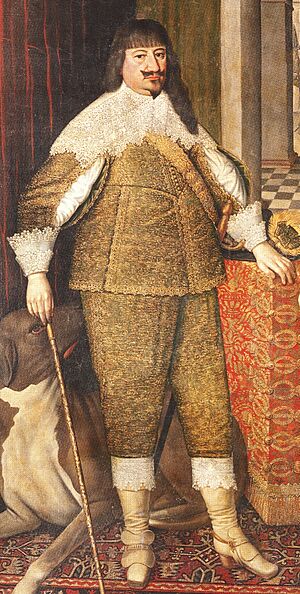
On March 19, 1637, a group of Pomeranian nobles asked the elector to wait on his claims until Sweden and Brandenburg reached an agreement. The elector refused. Bielke, on March 24, refused any talks with Brandenburg. While Bielke said on April 3 that he did not challenge Brandenburg's claim itself, he did challenge Brandenburg's ignoring of Swedish claims. Wrangel, on April 12, completely rejected Brandenburg's claim and told the Pomeranian nobles to stay loyal to Sweden. George William reacted on April 28, repeating his claims and threatening that the emperor would get involved. Ferdinand II issued a document confirming Brandenburg's right to take over. George William issued another document on May 22. The Pomeranians held a meeting between June 7 and 29. There, Bielke and the nobles agreed to resist Brandenburg's takeover.
In August 1637, an imperial army led by Matthias Gallas moved towards Pomerania's border with Mecklenburg. Swedish forces gathered on the Pomeranian side. Gallas pulled back in late October. But imperial forces led by von Bredow crossed into Western Pomerania on October 24/25. They took Tribsees, Loitz, Wolgast, and Demmin. The nobles of the duchy's southern areas changed their loyalty. They swore allegiance to the elector of Brandenburg on November 25. Several nobles from the eastern areas of Stolp and Schlawe met with the elector's representative in Danzig. They got permission to move to East Prussia on January 1, 1638. That same month, Emperor Ferdinand II gave the Duchy of Pomerania to Brandenburg as a fief (land held in exchange for loyalty). The nobility accepted this on January 26. The Pomeranian government resigned in March.
On April 3, 1638, the Swedish council discussed the Pomeranian issue. They decided to take over the duchy. On May 2, Axel Lillje and Johann Lilljehök were named Swedish governors of Pomerania. Their main job was military tasks. Other officials were appointed to manage the duchy. Johan Nicodemi Lilleström was asked to plan how Pomerania would become a full part of the Swedish Empire.
On July 28, 1638, Swedish field marshal Johan Banér attacked the imperial forces in Western Pomerania from Farther Pomerania. The fighting that followed badly damaged the duchy. By the end of the year, Banér was made general governor of the whole duchy. Brandenburg tried to prepare a military recapture between 1639 and 1641, but they didn't make any real progress. Attempts by Sweden and the Pomeranian nobility to bring back a civilian government also failed. On July 14, 1641, Sweden and Brandenburg agreed to a truce. However, talks in February 1642 and April 1643 did not lead to a final agreement.
Between September 1 and 7, 1643, imperial forces led by von Krockow invaded the Duchy of Pomerania. They took western Farther Pomerania. Swedish forces led by Hans Christoff von Königsmarck attacked Krockow on October 1. The battles lasted until November 12, when Krockow retreated, with Königsmarck's forces chasing him.
What Happened Next
When peace talks began in Osnabrück to end the Thirty Years' War, a Pomeranian group was there in early 1644. They were also present from October 1645 to August 1647. Stralsund had sent its own representatives. The rest of the duchy was represented by von Eickstedt and Runge, who were approved by both Sweden and Brandenburg. On August 3, George William of Brandenburg's group started to discuss dividing the duchy with Sweden. The Pomeranian nobles rejected a division in October. They urged Brandenburg to find other solutions. But the division was made final on January 28, 1647, in Osnabrück. It was signed as part of the Peace of Westphalia on October 24, 1648. Western Pomerania would stay with Sweden. Farther Pomerania would become a fief of Brandenburg. Swedish field-marshal Carl Gustaf Wrangel was made general governor of Pomerania in 1648. After the peace treaty, Sweden reduced its army in Pomerania, keeping between 2,000 and 4,000 soldiers.
Talks between Sweden and Brandenburg about the exact border began in early 1650. This led to another Treaty of Stettin which set the exact border on May 4, 1653. Bogislaw XIV was finally buried in Stettin on May 25, 1654.
See also
 In Spanish: Tratado de Stettin (1630) para niños
In Spanish: Tratado de Stettin (1630) para niños
- Pomerania during the Early Modern Age
- Capitulation of Franzburg
- Swedish Pomerania
- Treaty of Stettin (1570)
- Treaty of Stettin (1653)
- Treaty of Stettin (1715)


